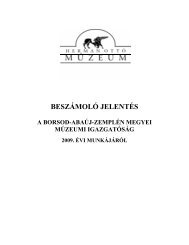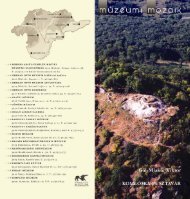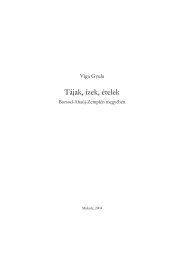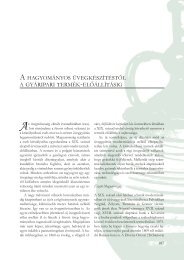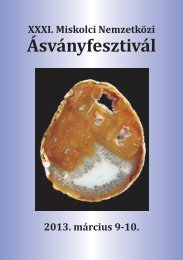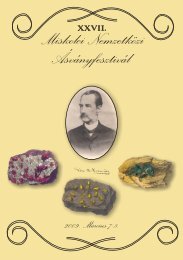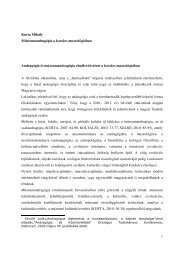Acta Mineralogica-Petrographica, Abstract Series 5, Szeged, 2006MONAZITE FROM A LOW TATRA GARNET LEUCOGRANITE: AGE, ORIG<strong>IN</strong> ANDRELATION TO GARNETPETRÍK, I. 1 , KONEČNÝ, P. 2 & HOVORKA, D. 31 Geological Institute, Slovak Academy of Sciences, Dúbravská 9, 84005 Bratislava, SlovakiaE-mail: igor.petrik@savba.sk2 Geological Survey of the Slovak Republic, Mlynská dolina 1, 81704 Bratislava, Slovakia3 Faculty of Sciences, Comenius University, Mlynská dolina G, 842 15 Bratislava, SlovakiaA garnet-bearing leucogranite occurs within the complexof ortho- and paragneisses on southern slopes of the NízkeTatry Mts. The rock is medium-grained leucogranite with 4%of biotite and up to 4% of garnet. K-feldspar (20%) isperthitic, interstitial, plagioclase (40%, An 13-20 ) forms smallphenocrysts. Garnet is euhedral (0.5–3 mm) partly chloritised.Its composition is (centre–rim): py 20–7 , spess 5–22 ,alm 72–67 , andr 2.5–2 , gross 0.5–3 . Muscovite was found withinfeldspars, rarely enclosing fibrolitic sillimanite. Among accessories,monazite is the most prominent forming largesubhedral crystals. It is accompanied by apatite and smallneedle-like zircons, and hosted by quartz, plagioclase or latemuscovite.The rock composition is peraluminous (A/CNK = 1.15)with low Rb/Sr ratio (0.33) and elevated MnO and HREE dueto accumulation of garnet. Zr and LREE saturation temperaturesgive 740 and 809 °C, respectively (WATSON &HARRISON 1983, MONTEL 1993), the higher LREEderivedvalue being probably due to inherited nature of alarge part of monazite.The big monazite grains commonly show brighter coresand darker rims due to increased Y contents. The darkerzones are saturated by Y as documented by small late xenotimesat monazite grain boundaries. Empirical thermometerof PYLE et al. (2001) yielded 650 °C for rims and 470 °C inthe core probably indicating a restite character of the core,which seems to be inherited from a metamorphic protolith ofthe granite. The high-Y rims result from exchange reactionwith garnet and are, therefore, interpreted as directly relatedto the granite formation. Garnet is considered a product ofincongruent vapour-absent melting of biotite:Bt + sill + qtz = grt + Kfs + meltThe present biotite may have formed by retrogression ofthe garnet on cooling segment of the P-T path. The assemblagebt – grt – plg – sill – H 2 O gives average T = 609 ±113 °C and P = 4.1 ± 1.9 kbar and 710 ± 139 °C and P = 6.3± 2.6 kbar for various garnet rim compositions(<strong>THE</strong>RMOCALC, HOLLAND & POWELL, 1998).More than 30 grains were dated by microprobe CamecaSX-100 (KONEČNÝ et al. 2005) some using detailed profiling:The brighter core containing low Y yielded 352 ± 5 Ma(n = 59) while the rims 334 ± 6 Ma (n = 24). The coincidenceof temperatures recorded by monazite Y-rich rims and garnet–biotitesuggests that the rims date the last retrogressiveevent in history of the rock. Retrogression of garnet by biotiteand sillimanite by muscovite requires free fluids, which couldhave acted also as agents between monazite and garnet.It is concluded that the leucogranite formed 330-340 Maago via biotite fluid-absent melting producing peritectic garnet.Fluids evolved during cooling retrogressed parts of garnetto biotite and mobilized Y, which attacked restitic monazite.Dissolved and re-precipitated monazite rims record thelower age limit of this event. The higher limit is given by theage of restitic low Y monazite centres between 350–360 Ma.ReferencesHOLLAND, T.J.B. & POWELL, R. (1998): Journal ofMetamorphic Geology, 16: 309–343.KONEČNÝ, P., SIMAN, P., HOLICKÝ, I., JANÁK, M. &KOLLÁROVÁ, V. (2004): Mineralia Slovaca, 36: 225–236.MONTEL, J-M. (1993): Chemical Geology, 110: 127–146.PYLE J.M., SPEAR, F.S., RUDNICK, R.L. &MCDONOUGH, W.F. (2001): Journal of Petrology, 42:2083–-2107.WATSON, E.B. & HARRISON, T.M. (1983): Earth andPlanetary Science Letters, 64: 295–304.94www.sci.u-szeged.hu/asvanytan/acta.htm
Acta Mineralogica-Petrographica, Abstract Series 5, Szeged, 2006PRELIM<strong>IN</strong>ARY DATA CONCERN<strong>IN</strong>G <strong>THE</strong> Cu, Au, Ag DISTRIBUTION <strong>IN</strong> <strong>THE</strong> BOLCANAORE DEPOSIT, METALIFERI MTS., ROMANIAPOPESCU, GH. C. & CIOACA, M.Department of Mineralogy, University of Bucharest, 1, N. Bălcescu Bvd., RO-010041 Bucharest, RomaniaE-mail: mihaela2012@yahoo.comThe Bolcana ore deposit is one of the 14 porphyry copperstructures belonging to the Neogene metallogenesis of theMetaliferi Mts. The deposit is located on the south-westernborder of the Brad–Săcărâmb District, approximately 25 kmNE of Deva. It constitutes a part of the Troiţa–Măgura metallogeneticfield, with an exceptional concentration of metallicelements, presenting a copper-gold ring-zoned structure(POPESCU & NEACSU, 2005); the porphyry mineralizationoccupies a central position around which gold-silver andpolymetallic veins have developed. The copper-gold mineralizationhas a spatial and genetical relationship with a subvolcanicbody of Sarmatian age, formed of amphibolebearingandesites/microdiorites. The structure exhibits abrecciated structure with intensely hydrothermally alteredmicroveins and/or impregnations within the host rock. Themain metallic minerals are pyrite, chalcopyrite, magnetite andsubordinately, bornite, hematite, molybdenite, and nativegold. The most abundant minerals are chalcopyrite and magnetite;subordinate amounts of pyrite and bornite occur in thecentral part of the ore deposit. The mineralization is superimposedon a potassic alteration zone, whereas pyrite becomesdominant towards the upper and marginal part of the intenselyargillized mineralized body. The copper-gold mineralizationis cross-cut by epithermal polymetallic veinletsformed of sphalerite, galena, pyrite, chalcopyrite, tetrahedrite,bournonite, marcasite, etc., associated with carbonates andquartz-gold veinlets.The ore deposit has been investigated with mining works(at five levels) and drill works spanning over 1000 m indepth. Such works have made possible to outline four cylindricalbreccia columns within the Bolcana subvolcano(“breccia pipe”) which were richer in mineralization (the F17,F282-F13, F21-F4 and F3 zones). Distribution of Cu, Au andAg marks an increase of the metal content with depth, and adirect correlation between Au and Cu. Distribution mapsdrafted for each horizon and outlining the four mineralizedcolumns mentioned above, show Cu contents of over 2% andAu contents of over 0.3 g/t, as well as the overlapping of Cu,Au and Ag mineralization in most situations. There are caseswhere copper, gold and silver occur separately, suggestingtwo stages of mineral genesis: one with copper and anotherone with gold-silver.ReferencePOPESCU, GH & NEACSU, A. (2005): In: Abstracts, Vol.37, No. 97, GSA Annual Meeting SLC 2005, p. 516.www.sci.u-szeged.hu/asvanytan/acta.htm 95
- Page 1:
MSCC33 rd MINERAL SCIENCES IN THE C
- Page 5 and 6:
Acta Mineralogica-Petrographica, Ab
- Page 7 and 8:
Acta Mineralogica-Petrographica, Ab
- Page 9 and 10:
Acta Mineralogica-Petrographica, Ab
- Page 11 and 12:
Acta Mineralogica-Petrographica, Ab
- Page 13 and 14:
Acta Mineralogica-Petrographica, Ab
- Page 15 and 16:
Acta Mineralogica-Petrographica, Ab
- Page 17 and 18:
Acta Mineralogica-Petrographica, Ab
- Page 19 and 20:
Acta Mineralogica-Petrographica, Ab
- Page 21 and 22:
Acta Mineralogica-Petrographica, Ab
- Page 23 and 24:
Acta Mineralogica-Petrographica, Ab
- Page 25 and 26:
Acta Mineralogica-Petrographica, Ab
- Page 27 and 28:
Acta Mineralogica-Petrographica, Ab
- Page 29 and 30:
Acta Mineralogica-Petrographica, Ab
- Page 31 and 32:
Acta Mineralogica-Petrographica, Ab
- Page 33 and 34:
Acta Mineralogica-Petrographica, Ab
- Page 35 and 36:
Acta Mineralogica-Petrographica, Ab
- Page 37 and 38:
Acta Mineralogica-Petrographica, Ab
- Page 39 and 40:
Acta Mineralogica-Petrographica, Ab
- Page 41 and 42:
Acta Mineralogica-Petrographica, Ab
- Page 43 and 44: Acta Mineralogica-Petrographica, Ab
- Page 45 and 46: Acta Mineralogica-Petrographica, Ab
- Page 47 and 48: Acta Mineralogica-Petrographica, Ab
- Page 49 and 50: Acta Mineralogica-Petrographica, Ab
- Page 51 and 52: Acta Mineralogica-Petrographica, Ab
- Page 53 and 54: Acta Mineralogica-Petrographica, Ab
- Page 55 and 56: Acta Mineralogica-Petrographica, Ab
- Page 57 and 58: Acta Mineralogica-Petrographica, Ab
- Page 59 and 60: Acta Mineralogica-Petrographica, Ab
- Page 61 and 62: Acta Mineralogica-Petrographica, Ab
- Page 63 and 64: Acta Mineralogica-Petrographica, Ab
- Page 65 and 66: Acta Mineralogica-Petrographica, Ab
- Page 67 and 68: Acta Mineralogica-Petrographica, Ab
- Page 69 and 70: Acta Mineralogica-Petrographica, Ab
- Page 71 and 72: Acta Mineralogica-Petrographica, Ab
- Page 73 and 74: Acta Mineralogica-Petrographica, Ab
- Page 75 and 76: Acta Mineralogica-Petrographica, Ab
- Page 77 and 78: Acta Mineralogica-Petrographica, Ab
- Page 79 and 80: Acta Mineralogica-Petrographica, Ab
- Page 81 and 82: Acta Mineralogica-Petrographica, Ab
- Page 83 and 84: Acta Mineralogica-Petrographica, Ab
- Page 85 and 86: Acta Mineralogica-Petrographica, Ab
- Page 87 and 88: Acta Mineralogica-Petrographica, Ab
- Page 89 and 90: Acta Mineralogica-Petrographica, Ab
- Page 91 and 92: Acta Mineralogica-Petrographica, Ab
- Page 93: Acta Mineralogica-Petrographica, Ab
- Page 97 and 98: Acta Mineralogica-Petrographica, Ab
- Page 99 and 100: Acta Mineralogica-Petrographica, Ab
- Page 101 and 102: Acta Mineralogica-Petrographica, Ab
- Page 103 and 104: Acta Mineralogica-Petrographica, Ab
- Page 105 and 106: Acta Mineralogica-Petrographica, Ab
- Page 107 and 108: Acta Mineralogica-Petrographica, Ab
- Page 109 and 110: Acta Mineralogica-Petrographica, Ab
- Page 111 and 112: Acta Mineralogica-Petrographica, Ab
- Page 113 and 114: Acta Mineralogica-Petrographica, Ab
- Page 115 and 116: Acta Mineralogica-Petrographica, Ab
- Page 117 and 118: Acta Mineralogica-Petrographica, Ab
- Page 119 and 120: Acta Mineralogica-Petrographica, Ab
- Page 121 and 122: Acta Mineralogica-Petrographica, Ab
- Page 123 and 124: Acta Mineralogica-Petrographica, Ab
- Page 125 and 126: Acta Mineralogica-Petrographica, Ab
- Page 127 and 128: Acta Mineralogica-Petrographica, Ab
- Page 129 and 130: Acta Mineralogica-Petrographica, Ab
- Page 131 and 132: Acta Mineralogica-Petrographica, Ab
- Page 133 and 134: Acta Mineralogica-Petrographica, Ab



